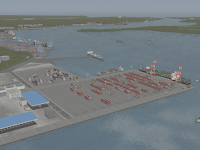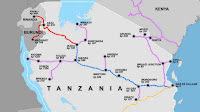Kenya Port's Post-Panamax project ahead of schedule
 |
| An Aerial view of the Mombasa port |
THE CONSTRUCTION OF the second container terminal at the Port of Mombasa in
Kenya is three months ahead of schedule,
we can report. This is the second project in the on-going upgrading of the Port
into a Mega port to be completed ahead of the schedule in less than a year.
A mega port is a full service port that has the capacity to handle
post-Panamax vessels. These are vessels that can carry more than 10,000 TEUs
and are up to 350 metres long.
Last year, the deepening of the port and the widening of the Likoni channel
and the turning basin was completed four months ahead of schedule.
According to the Managing Director of the Kenya Ports Authority, by the end
of May this year, construction of the second container terminal, which began
last December, was 38 per cent complete. At that point, he said, it was three
months ahead of schedule meaning that Phase of one of the project could be
complete by the end of 2015. Initially, the project was expected to come on
stream in March 2016.
 |
| A post-Panamax marine Vessel |
The completion of this phase will increase the Port’s containers handling
capacity by 1.25 Million TEUs raising the total container handling capacity to
1.7 million TEUs. Currently the container terminal has a capacity of 450,000
TEUs.
Robust economic growth both in Kenya and among her landlocked neighbours
such as Uganda, Rwanda, Burundi and South Sudan generated increased demand for
imports and exports through the port.
This growth coupled with the rapid expansion of vessel sizes has stretched
the capacity of the port, which is the hub of shipping business in east and
central Africa, to a snapping point.
For instance the container terminal
was built in 1980 to handle just 250,000 TEUs a year. Last year, it handled a
total of 903,463 TEUs. That is four-times beyond its capacity. This resulted in
unwarranted delays in cargo discharge and the associated costs. Being the
gateway to east Africa, congestion at the port increased the cost of doing
business in the region.
The second source of pressure for the port was advance in construction of
freighters. In order to minimize average costs, shipping Lines were investing
in large capacity vessels. In 1996, says an analysis by the Kenya Ports
Authority which is in charge of all ports in Kenya, the largest vessel had a
capacity of 4000 TEUs. This grew progressively to 11,000 TEUs in 2011 and is
projected to rise to 20,000 TEUs by 2020.
This growth in vessels size also added pressure on major ports in Africa to
invest in capacity expansion. The Mombasa Port was no exception. It has undergone
several upgrades in the recent past the most recent of which was the dredging
of the channels to -15 Metres.
The most recent expansion the upgrade of berth No 19 has added another
200,000 TEU’s to the existing capacity. The new capacity has raised the
container handling capacity to 450 TEUs from this year on. It is on this
capacity that the second container terminal will add 1.25 million TEUs,
bringing the total capacity to 1.7 million TEUs.



Comments
Post a Comment